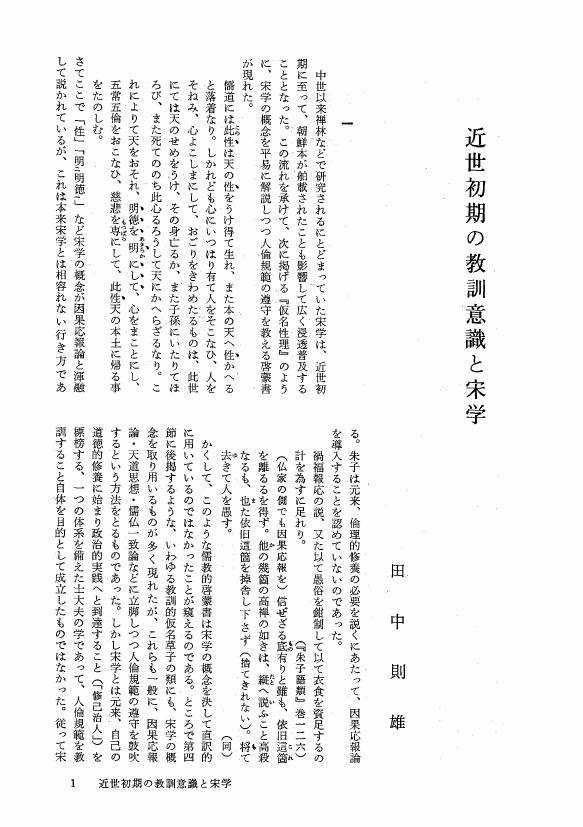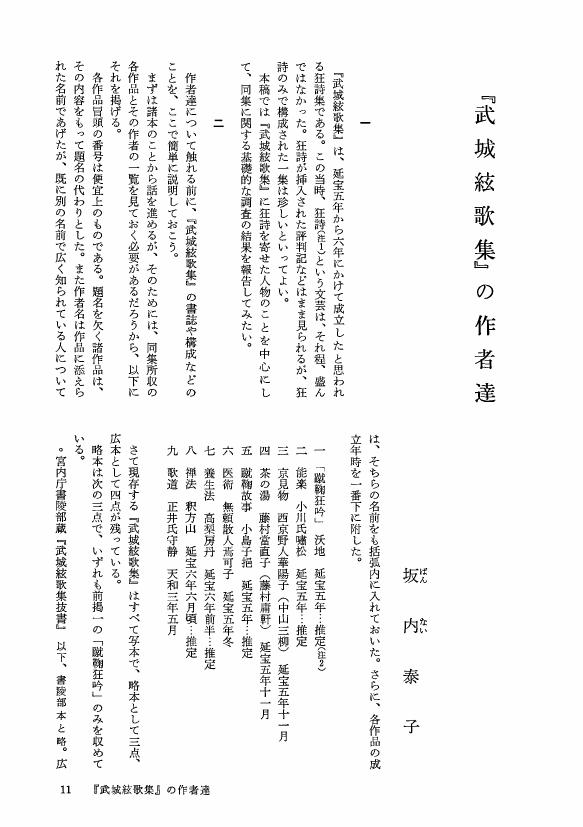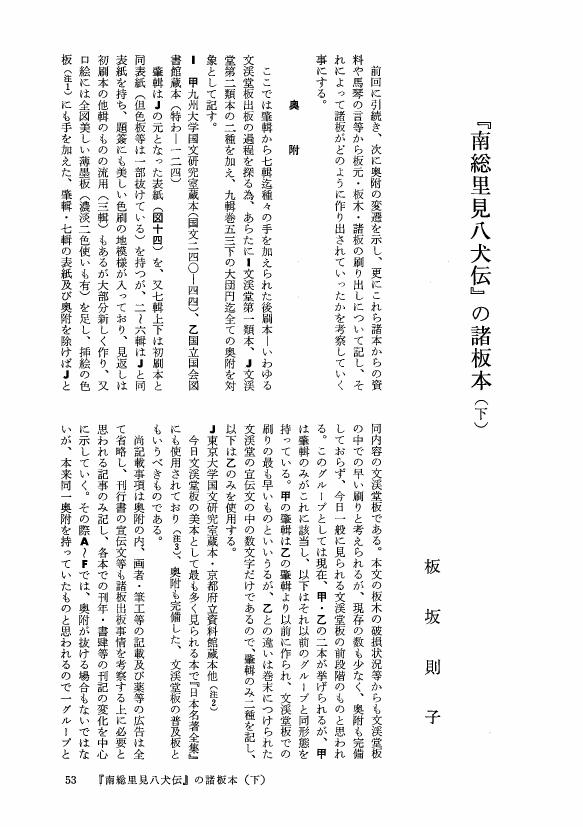2 0 0 0 OA 平賀源内『根南志具佐』のカッパ図
- 著者
- 吉田 宰
- 出版者
- 日本近世文学会
- 雑誌
- 近世文藝 (ISSN:03873412)
- 巻号頁・発行日
- vol.112, pp.13-26, 2020 (Released:2021-01-31)
Nenashi-gusa (1763) is Hiraga-Gennai’s drama which was based on the death by drowning of Ogino-Yaegiri, an “oyama” kabuki actor. In the drama a kappa (a Japanese water goblin) plays an important part as a guide who sends Yaegiri to hell. There is an illustration of the kappa in the fifth volume, but very little has been said about it except in Teiri Nakamura’s Kappa-no-nihon-shi (1996). It is very likely that the author borrowed the illustration from Gotō-Rishun’s Zuikan-shashin (1757) with the aim of entertaining his acquaintances who must have noticed that it implicitly referred to the reported appearance of a kappa in the year before the publication of the drama. In addition to an analysis of the illustration, this article explores the structural similarity between Nenashi-gusa and its sequel, the probable influence of the author’s personal relations through herbal medicine on the formation of the drama, and so on.
2 0 0 0 OA 嵯峨本『伊勢物語』の活字と組版
- 著者
- 鈴木 広光
- 出版者
- 日本近世文学会
- 雑誌
- 近世文藝 (ISSN:03873412)
- 巻号頁・発行日
- vol.84, pp.1-16, 2006 (Released:2017-04-28)
2 0 0 0 OA 『因果物語』蛇道心説話をめぐって ―唱導と文芸の間―
- 著者
- 堤 邦彦
- 出版者
- 日本近世文学会
- 雑誌
- 近世文藝 (ISSN:03873412)
- 巻号頁・発行日
- vol.43, pp.1-12, 1985 (Released:2017-04-28)
2 0 0 0 OA 国際シンポジウム傍聴記 ―江戸文芸研究がおかれている危機と可能性―
- 著者
- 黒石 陽子
- 出版者
- 日本近世文学会
- 雑誌
- 近世文藝 (ISSN:03873412)
- 巻号頁・発行日
- vol.77, pp.49-54, 2003 (Released:2017-04-28)
2 0 0 0 安政江戸地震と漢詩:―国会図書館蔵稿本『禍福集』の分析を中心に―
- 著者
- 松葉 友惟
- 出版者
- 日本近世文学会
- 雑誌
- 近世文藝 (ISSN:03873412)
- 巻号頁・発行日
- vol.114, pp.31-43, 2021
Many Chinese poems were written about the big earthquake in Edo which occurred on October 2, 1885 or the second year of the Ansei Period. This fad for earthquake poetry was more widespread than has ever been thought before. This paper examines what it was through the bibliographical and textual analysis of <i>Kafuku-shū</i>, the collection of earthquake poems in the Gakken Library of the National Diet Library. As the collection shows, most of those poems were protestation against the government made by poets who fell victim to the earthquake. It tells us that the act of writing in Chinese verse was an important means of expressing one's political consciousness. The frequent use of the title "Jisin-kō" refers back to the earthquake songs in the Qing dynasty or those written about the Iga earthquake in 1884 which must have triggered the popularity of earthquake poetry in 1885.
2 0 0 0 烏亭焉馬作『蚊不喰呪咀曽我 』:―会話体滑稽本の先蹤として―
- 著者
- マスキオ パオラ
- 出版者
- 日本近世文学会
- 雑誌
- 近世文藝 (ISSN:03873412)
- 巻号頁・発行日
- vol.114, pp.45-59, 2021
Utei-Enba wrote <i>Ka-ni-kuwarenu-majinai-Soga</i> (1779) after the fashion of the <i>kabuki</i> play of the Soga brothers' revenge to vividly depict the scene of card gambling in colloquial style. This paper examines how the author was inspired by several dramatic works in writing it and points out that the narrative and structural characteristics of "kokkeibon" fiction can be already found in it. The origin of humorous stories in colloquial style is traced through Manzōtei's comical book <i>Inaka-shibai</i> (1787) to "ukiyo-monomane" mimic performance, but the use of dialects in them can be attributed to vernacular plays in <i>kabuki</i>. It is thus likely that <i>Ka-ni-kuwarenu-majinai-Soga</i>, a dramatic novel written in vernacular style, was the earliest form of "kokkeibon" novel which had a great influence on Shikite-Sanba and other writers of later generations.
2 0 0 0 OA 〔講演要旨〕明清小説と善書 ―日本近世小説も視野に入れて―
- 著者
- 小川 陽一
- 出版者
- 日本近世文学会
- 雑誌
- 近世文藝 (ISSN:03873412)
- 巻号頁・発行日
- vol.79, pp.29-43, 2004 (Released:2017-04-28)
2 0 0 0 OA 享和期京都歌壇の一側面 ―大愚歌合一件を通して―
- 著者
- 盛田 帝子
- 出版者
- 日本近世文学会
- 雑誌
- 近世文藝 (ISSN:03873412)
- 巻号頁・発行日
- vol.62, pp.40-50, 1995 (Released:2017-04-28)
2 0 0 0 パネルディスカッション「翻刻の未来」傍聴記
- 著者
- 光延 真哉
- 出版者
- 日本近世文学会
- 雑誌
- 近世文藝 (ISSN:03873412)
- 巻号頁・発行日
- vol.101, pp.59-64, 2015
2 0 0 0 パネルディスカッション1「翻刻の未来」概要
- 著者
- 川平 敏文
- 出版者
- 日本近世文学会
- 雑誌
- 近世文藝 (ISSN:03873412)
- 巻号頁・発行日
- vol.101, pp.49-58, 2015
2 0 0 0 OA 傀儡子から魁蕾子へ ―馬琴異称にみる執筆意識の変化―
- 著者
- 菱岡 憲司
- 出版者
- 日本近世文学会
- 雑誌
- 近世文藝 (ISSN:03873412)
- 巻号頁・発行日
- vol.93, pp.30-44, 2011 (Released:2017-04-28)
2 0 0 0 OA 幕府御大工頭鈴木長頼の文事
- 著者
- 真島 望
- 出版者
- 日本近世文学会
- 雑誌
- 近世文藝 (ISSN:03873412)
- 巻号頁・発行日
- vol.105, pp.1-15, 2017 (Released:2017-07-31)
Suzuki-Nagayori is a highly cultured master carpenter who served the Tokugawa shogunate in the early Edo Period. The carpenter became versed in poetry written in Chinese through his close relation to Hitomi-Chikudō with whom he was engaged in exchanging poems. He was instructed in waka poetry by Shimizu-Sōsen who made helpful comments on his works. He sometimes collaborated with both mentors to hold poetry exhibitions as if to embody the contemporary literary tendency of making no distinction between Japanese and Chinese writings. Suzuki also compiled a history book in the form of a comparative study of Japan, China, and Korea. He modeled it on the compilation of national history by the Hayashi clan which then caused a fad for writing history in a poetical style. In the same method he edited a poetry anthology which was remarkable for his innovative attempt to include Korean poems. In this way he played an important role in widely popularizing the Hayashi clan’s academic knowledge. His career as an intellectual will provide excellent material for studying Edo culture during the Genroku and the Kyōho Periods.
2 0 0 0 OA 江戸歌舞伎絵本番付考
- 著者
- 神楽岡 幼子
- 出版者
- 日本近世文学会
- 雑誌
- 近世文藝 (ISSN:03873412)
- 巻号頁・発行日
- vol.52, pp.36-50, 1990 (Released:2017-04-28)
2 0 0 0 OA 浄瑠璃の詞章と曲節との関係
- 著者
- 渥美 かをる
- 出版者
- 日本近世文学会
- 雑誌
- 近世文藝 (ISSN:03873412)
- 巻号頁・発行日
- vol.1, pp.4-13, 1954 (Released:2017-04-28)
1 0 0 0 OA 家集を出版すること ―賀茂季鷹『雲錦翁家集』を巡って―
- 著者
- 盛田 帝子
- 出版者
- 日本近世文学会
- 雑誌
- 近世文藝 (ISSN:03873412)
- 巻号頁・発行日
- vol.106, pp.29-41, 2017 (Released:2018-01-31)
During the Bunka-Bunsei Period the publication of private poetry collections suddenly came into fashion. This article will elucidate this literary phenomenon through the publishing history of Kamo-no-Suetaka’s private collection Unkin-ou-kashū. The collection was very popular; it was reprinted several times by different publishers after 1,000 copies of the first edition were sold. But at first the plebeian poet of the Dōjō School declined to make public his work in spite of recommendations from his colleagues because he hated to be compared with Motoori-Norinaga who issued his poetry collection Suzunoya-shū. After thirty-year silence, however, Suetaka decided to publish his poems, not only moved by his literary friend Nagaharu-Sukeyoshi’s strong encouragement but also stimulated by Norinaga’s successful dedication of his collection to a royal member. Or he did so in the cultural context where any poets, plebeian or not, came to think it a duty to publish their own works in a less restrictive atmosphere of the age.
1 0 0 0 OA 近世初期の教訓意識と宋学
- 著者
- 田中 則雄
- 出版者
- 日本近世文学会
- 雑誌
- 近世文藝 (ISSN:03873412)
- 巻号頁・発行日
- vol.57, pp.1-11, 1993 (Released:2017-04-28)
1 0 0 0 OA 『斯波遠説七長臣』考
- 著者
- 小笠原 広安
- 出版者
- 日本近世文学会
- 雑誌
- 近世文藝 (ISSN:03873412)
- 巻号頁・発行日
- vol.117, pp.45-58, 2023 (Released:2023-07-31)
Shibaensetsu-shichininkarō (published Bunsei 4; 1821) is a “yomihon” of 5 kan / 6 satsu and is an Oie-sōdōmono (stories of feuds within samurai families) based on Sugawara-denju-tenaraikagami, etc. Although its frog monster draws attention, it has received low acclaim to date. However, the true villain is concealed until the last part (kan) of the story, and this device of a surprise ending could be called a new departure in “yomihon”. I investigate how initially, this work was scheduled to be published by a different publisher in a total of 9 kan, and due to the sudden change, the 5 kan were written hurriedly. Next, I focus on the illustration and Chinese poem placed at the beginning of the 4th kan, and demonstrate how the “Sewing corpus” of 7-5 meter is used in the scene that corresponds to the illustration, and how the Chinese poem is cited from Qing poem Nulang-ci, etc., seeing a perspective toward women. The advertisement at the end of the work for “Senjokō” fragrance, of the shop of Ōshima Den’emon, one of the publishers, also suggests an awareness of female readers. It also introduces Tamenaga-Shunsui’s critique of Kokuga, indicating the artistic contact between the two of them. In these ways, I show this work to be an ambitious work by Kokuga seeking new expression, and planning an expansion of readership.
1 0 0 0 OA 『武徳鎌倉旧記』『鎌倉繁栄広記』をめぐって
- 著者
- 倉員 正江
- 出版者
- 日本近世文学会
- 雑誌
- 近世文藝 (ISSN:03873412)
- 巻号頁・発行日
- vol.40, pp.13-26, 1984 (Released:2017-04-28)
1 0 0 0 OA 『武城絃歌集』の作者達
- 著者
- 坂内 泰子
- 出版者
- 日本近世文学会
- 雑誌
- 近世文藝 (ISSN:03873412)
- 巻号頁・発行日
- vol.38, pp.11-28, 1983 (Released:2017-04-28)
1 0 0 0 OA 『南総里見八犬伝』の諸板本(下)
- 著者
- 板坂 則子
- 出版者
- 日本近世文学会
- 雑誌
- 近世文藝 (ISSN:03873412)
- 巻号頁・発行日
- vol.31, pp.53-70, 1979 (Released:2017-04-28)











